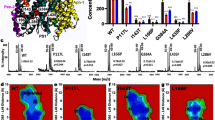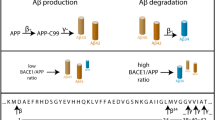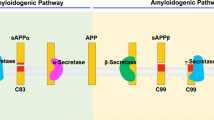Abstract
Mutations in presenilin genes account for the majority of the cases of the familial form of Alzheimer's disease (FAD). Presenilin is essential for γ-secretase activity, a proteolytic activity involved in intramembrane cleavage of Notch and β-amyloid precursor protein (βAPP)1,2. Cleavage of βAPP by FAD mutant presenilin results in the overproduction of highly amyloidogenic amyloid β42 peptides3,4,5,6. γ-Secretase activity requires the formation of a stable, high-molecular-mass protein complex7,8,9,10,11 that, in addition to the endoproteolysed fragmented form of presenilin, contains essential cofactors including nicastrin12,13,14, APH-1 (refs 15–18) and PEN-2 (refs 16, 19). However, the role of each protein in complex formation and the generation of enzymatic activity is unclear. Here we show that Drosophila APH-1 (Aph-1) increases the stability of Drosophila presenilin (Psn) holoprotein in the complex. Depletion of PEN-2 by RNA interference prevents endoproteolysis of presenilin and promotes stabilization of the holoprotein in both Drosophila and mammalian cells, including primary neurons. Co-expression of Drosophila Pen-2 with Aph-1 and nicastrin increases the formation of Psn fragments as well as γ-secretase activity. Thus, APH-1 stabilizes the presenilin holoprotein in the complex, whereas PEN-2 is required for endoproteolytic processing of presenilin and conferring γ-secretase activity to the complex.
This is a preview of subscription content, access via your institution
Access options
Subscribe to this journal
Receive 51 print issues and online access
$199.00 per year
only $3.90 per issue
Buy this article
- Purchase on Springer Link
- Instant access to full article PDF
Prices may be subject to local taxes which are calculated during checkout





Similar content being viewed by others
References
De Strooper, B. et al. Deficiency of presenilin-1 inhibits the normal cleavage of amyloid precursor protein. Nature 391, 387–390 (1998)
De Strooper, B. et al. A presenilin-1-dependent γ-secretase-like protease mediates release of Notch intracellular domain. Nature 398, 518–522 (1999)
Duff, K. et al. Increased amyloid-β42(43) in brains of mice expressing mutant presenilin 1. Nature 383, 710–713 (1996)
Borchelt, D. R. et al. Familial Alzheimer's disease-linked presenilin 1 variants elevate Aβ1-42/1-40 ratio in vitro and in vivo. Neuron 17, 1005–1013 (1996)
Citron, M. et al. Mutant presenilins of Alzheimer's disease increase production of 42-residue amyloid β-protein in both transfected cells and transgenic mice. Nature Med. 3, 67–72 (1997)
Tomita, T. et al. The presenilin 2 mutation (N141I) linked to familial Alzheimer disease (Volga German families) increases the secretion of amyloid β protein ending at the 42nd (or 43rd) residue. Proc. Natl Acad. Sci. USA 94, 2025–2030 (1997)
Ratovitski, T. et al. Endoproteolytic processing and stabilization of wild-type and mutant presenilin. J. Biol. Chem. 272, 24536–24541 (1997)
Thinakaran, G. et al. Evidence that levels of presenilins (PS1 and PS2) are coordinately regulated by competition for limiting cellular factors. J. Biol. Chem. 272, 28415–28422 (1997)
Capell, A. et al. The proteolytic fragments of the Alzheimer's disease-associated presenilin-1 form heterodimers and occur as a 100-150-kDa molecular mass complex. J. Biol. Chem. 273, 3205–3211 (1998)
Tomita, T. et al. The first proline of PALP motif at the C terminus of presenilins is obligatory for stabilization, complex formation and γ-secretase activities of presenilins. J. Biol. Chem. 276, 33273–33281 (2001)
Takasugi, N. et al. The mechanism of γ-secretase activities through high molecular weight complex formation of presenilins is conserved in Drosophila melanogaster and mammals. J. Biol. Chem. 277, 50198–50205 (2002)
Yu, G. et al. Nicastrin modulates presenilin-mediated notch/glp-1 signal transduction and βAPP processing. Nature 407, 48–54 (2000)
Hu, Y., Ye, Y. & Fortini, M. E. Nicastrin is required for γ-secretase cleavage of the Drosophila Notch receptor. Dev. Cell 2, 69–78 (2002)
Edbauer, D., Winkler, E., Haass, C. & Steiner, H. Presenilin and nicastrin regulate each other and determine amyloid β-peptide production via complex formation. Proc. Natl Acad. Sci. USA 99, 8666–8671 (2002)
Goutte, C., Tsunozaki, M., Hale, V. A. & Priess, J. R. APH-1 is a multipass membrane protein essential for the Notch signaling pathway in Caenorhabditis elegans embryos. Proc. Natl Acad. Sci. USA 99, 775–779 (2002)
Francis, R. et al. aph-1 and pen-2 are required for notch pathway signaling, γ-secretase cleavage of βAPP, and presenilin protein accumulation. Dev. Cell 3, 85–97 (2002)
Lee, S. F. et al. Mammalian APH-1 interacts with presenilin and nicastrin and is required for intramembrane proteolysis of amyloid-β precursor protein and notch. J. Biol. Chem. 277, 45013–45019 (2002)
Gu, Y. et al. APH-1 interacts with mature and immature forms of presenilins and nicastrin and may play a role in maturation of presenilin-nicastrin complexes. J. Biol. Chem. 278, 7374–7380 (2003)
Steiner, H. et al. PEN-2 is an integral component of the γ-secretase complex required for coordinated expression of presenilin and nicastrin. J. Biol. Chem. 277, 39062–39065 (2002)
Ui, K. et al. Newly established cell lines from Drosophila larval CNS express neural specific characters. In Vitro Cell. Dev. Biol. Anim. 30A, 209–216 (1994)
Elbashir, S. M. et al. Duplexes of 21-nucleotide RNAs mediate RNA interference in cultured mammalian cells. Nature 411, 494–498 (2001)
Fortini, M. E. γ-secretase-mediated proteolysis in cell-surface-receptor signalling. Nature Rev. Mol. Cell. Biol. 3, 673–684 (2002)
Urban, S. & Freeman, M. Intramembrane proteolysis controls diverse signalling pathways throughout evolution. Curr. Opin. Genet. Dev. 12, 512–518 (2002)
Fukumoto, H. et al. Primary cultures of neuronal and non-neuronal rat brain cells secrete similar proportions of amyloid β peptides ending at Aβ40 and Aβ42. Neuroreport 10, 2965–2969 (1999)
Thinakaran, G. et al. Stable association of presenilin derivatives and absence of presenilin interactions with APP. Neurobiol. Dis. 4, 438–453 (1998)
Morohashi, Y. et al. Molecular cloning and characterization of CALP/KChIP4, a novel EF-hand protein interacting with presenilin 2 and voltage-gated potassium channel subunit Kv4. J. Biol. Chem. 277, 14965–14975 (2002)
Suzuki, N. et al. An increased percentage of long amyloid β protein secreted by familial amyloid β protein precursor (βAPP717) mutants. Science 264, 1336–1340 (1994)
Iwatsubo, T. et al. Visualization of Aβ42(43) and Aβ40 in senile plaques with end-specific Aβ monoclonals: evidence that an initially deposited species is Aβ42(43). Neuron 13, 45–53 (1994)
Acknowledgements
We thank M. Miura, H. Kanuka, T. Igaki, K. Tei, H. Bito, M. Nakafuku and Y. Gotoh for suggestions on S2 and BG2 cells and RNAi assays; G. L. Boulianne, S. Cohen and Y. Ihara for providing Psn cDNA, anti-Smo antibody and anti-C4 antibody, respectively; Takeda Chemical Industries for continuous support to our studies; D.M.A. Mann for comments on the manuscript; and Y. Morohashi, N. Isoo, S. Tanaka and C. Sato for discussions and technical assistance. This work was supported by grants-in-aid from the Ministry of Health and Welfare and the Ministry of Education, Science, Culture and Sports for the 21st Century Center of Excellence programme, Japan. N.T. is a Research Fellow of the Japan Society for the Promotion of Science.
Author information
Authors and Affiliations
Corresponding authors
Ethics declarations
Competing interests
The authors declare that they have no competing financial interests.
Supplementary information
Rights and permissions
About this article
Cite this article
Takasugi, N., Tomita, T., Hayashi, I. et al. The role of presenilin cofactors in the γ-secretase complex. Nature 422, 438–441 (2003). https://doi.org/10.1038/nature01506
Received:
Accepted:
Published:
Issue Date:
DOI: https://doi.org/10.1038/nature01506
Comments
By submitting a comment you agree to abide by our Terms and Community Guidelines. If you find something abusive or that does not comply with our terms or guidelines please flag it as inappropriate.



